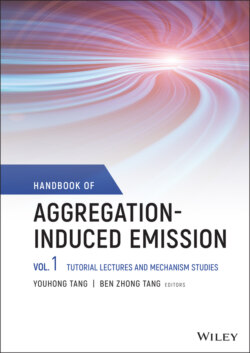Читать книгу Handbook of Aggregation-Induced Emission, Volume 1 - Группа авторов - Страница 42
2.4.3 Isotope Effect vs DRE
ОглавлениеIsotope effect (IE) has been widely applied to probe the excited‐state decay process [62, 63]. For conventional luminogens, deuteration always causes the remarkable decrease of kic while almost has no effect on kr, leading to greatly increased ΦF. It is easy to understand because under the displaced harmonic oscillator model based on FGR, kic is proportional to when assuming one average accepting‐mode approximation, in which S denotes the Huang–Rhys factor and is determined by normal mode reorganization energy S = λ/ℏ. The reorganization energy can be obtained from the calculated excitation energies at the equilibrium geometries of S0 and S1 (λ = ΔES1 − geom − ΔES0 − geom), which is independent of isotopic substitution owing to the same equilibrium geometries and electronic‐state energy after deuteration. Thus, the decrease of frequencyby deuteration implies the increase of Sj, which largely decreases kic owing to the exponentially proportional relation between kic and –S mentioned above. It should be known that the conventional luminogens have little DRE for their planar and rigid geometries and the above approximation is suitable for them. While for flexible AIEgens with rotational groups in solution, beyond the displaced harmonic oscillator model, the mixing of different vibrational modes (so‐called DRE) must be considered in kic. The DRE always occurs among low‐frequency modes, thus becoming more serious for much more active low‐frequency modes after deuteration, which sharply increases the kic. Therefore, the deuteration gives rise to two competitive effects on kic: the normal negative effect through increasing Sj and the abnormally positive effect via the enhancement of DRE (Figure 2.7a) [64]. Thus, it can also be easily understood that AIEgens exhibit normal negative IE because of the reduction of the electron–vibration coupling and vibration–vibration mixture upon aggregation. On the basis of the above, it is inferred that for AIEgens, a more remarkable IE exists in solid phase than in the solution phase, while for non‐AIEgens, high IE is expected to occur in both solid and solution phases. And we proposed that the IE can be used as a method to probe the AIE property of emitters and confirm the mixture of vibrational modes in the excited‐state decay process at the microscopic level.
Figure 2.6 (a) Calculated λj versus ωj in both solution and solid phases for HPDMCb. (b) Calculated resonance Raman spectroscopy in both solution and solid phases for HPDMCb.
Source: Reproduced from Ref. [61]. Copyright 2015 American Chemical Society.
The kr, kic, and IE of five AIEgens (HPS [37], BtTPS [65], HPDMCb [60], TPBD [56], and DPTDTP [66]) and four non‐AIEgens (BPS [67], perylene [68], DSB [69], and anthracene [68]) in both solution and solid states were calculated by combining the PCM and hybrid QM/MM models, respectively [64]. As shown in Table 2.6, it is found that the kic decreases sharply by several orders of magnitude from the solution to solid phase for AIEgens but suffers a tiny change for non‐AIEgens. As shown in Figure 2.7b, it is found that (i) the IE for all cases is negative; (ii) for AIEgens, the IE is minor in solution (~10%) but becomes remarkable in solid phases (~65–95%); (iii) for non‐AIEgens, the IE results in both solution and solid phases are close to each other and fall in the range of −40 to −90%. The calculated isotopic characteristic of AIEgens is further verify by experiments for HPS before and after deuteration; the experimental IEs well reproduce the calculated results with very little IE in solution but remarkably in solid phase. Thus, the proposed IE scheme further verifies the AIE mechanism theoretically and experimentally in which the nonradiative decay channels are blocked greatly owing to the decoupling of vibration–vibration and electron–vibration and then turning the fluorescence on.
Figure 2.7 (a) Representation of the isotope effect on kic. (b) IE results for AIEgens and non‐AIEgens.
Source: Reproduced from Ref. [64]. Copyright 2016 The Royal Society of Chemistry.
